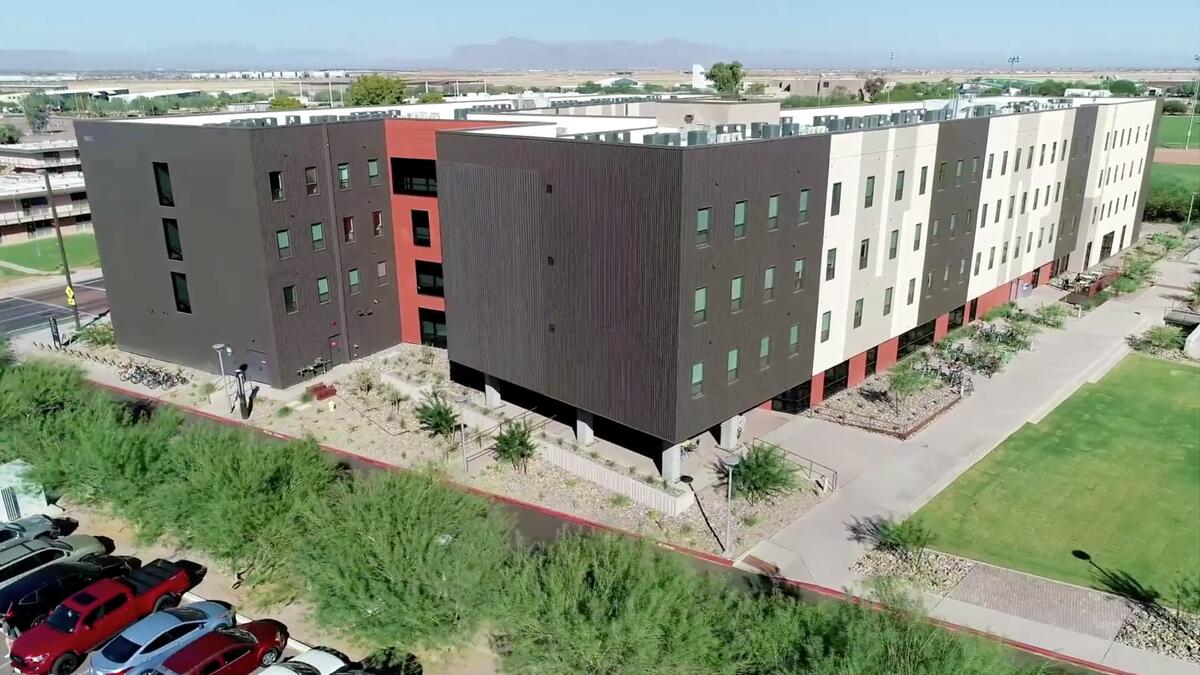Editor’s note: This story is being highlighted in ASU Now’s year in review. Read more top stories from 2020.
Arizona State University is celebrating the official grand opening of Lantana Hall — the university’s newest residence hall, which opened in fall 2020 on the Polytechnic campus.
The four-story, state-of-the-art facility, located on the north side of campus near Century Hall, not only provides 374 beds for the Polytechnic campus’ growing student population, it also contains about 8,500 square feet of academic space on the first floor, including two classrooms, multiple offices, conference rooms and lounge spaces conducive to a “live-learn” experience.
“It’s indicative of the success of the Polytechnic campus, the Polytechnic spirit, our relationship with the city of Mesa, the building of a university campus in Mesa, our connection between the Poly campus and downtown Mesa — all these things,” ASU President Michael Crow said. “We’re very excited about both the Polytechnic campus and Lantana Hall getting off the ground.”
The Polytechnic campus gives students access to seven ASU colleges and schools, including Barrett, The Honors College. Lantana Hall will serve as a home for the Barrett community’s first-year to fourth-year students. The Barrett suite will also provide a place where honors students can meet, collaborate and inspire.
Take a 360 virtual tour of Lantana Hall
“We’ve got a global classroom that allows students to work together across campuses but also with national, international universities,” said Thomas Sugar, associate dean of Barrett, The Honors College at the Polytechnic campus. “This is a place where students can learn and grow and build their future, and build their success.”
In line with ASU’s sustainability goals, Lantana Hall is on track to receive the highest certification from the U.S. Green Building Council: LEED Platinum. This would be ASU’s first LEED Platinum-certified residence hall. The 113,821-square-foot building was constructed using a wooden frame and a concrete podium hybrid system with a shell including accent metal paneling and fiber cement board. Seventy-five percent of the waste generated during this project was diverted to recycling facilities. The project was completed on time and under budget.
“The ASU Poly campus is an important asset in Mesa and particularly East Mesa. ASU’s presence in Mesa enhances the community and it enhances its economic potential,” Mesa Mayor John Giles said. “There’s a lot of excitement about the campus growing up by adding more modern places for students to live, which makes it more attractive for enrollment growth.”
Lantana Hall offers students two different floor plans. The four-bedroom suites are about 864 square feet with two ensuite bathrooms. The semi suites, which offer double occupancy, are about 288 square feet and contain an ensuite bathroom. Each residential floor has a large common lounge or “living room” area with a kitchen and outdoor amenity space. Each floor is also equipped with two quiet lounges for students who are looking for a more intimate study space.
“One of the great things about Lantana Hall is how there’s classrooms built right into the dorms, so students can walk right down to the first floor and be right in class within minutes,” resident Thomas Goers said.
More Environment and sustainability

Majority of American religious leaders silently believe in climate change, ASU study shows
Many Americans turn to religious leaders for guidance on matters of faith and morality.With this in mind, a new study, led by a researcher from Arizona State University, suggests that congregations…

A new university prototype for a thriving world
The challenges for our world’s health and the future of humanity and other life-forms command urgency — and the university is accelerating its wide-reaching collaborative work to help keep the planet…

From K–12 to corporate upskilling, ASU guides learners of all ages to design a sustainable future
Editor’s note: This story is part of a series exploring how ASU tackles complex problems to create a thriving future.When Kennedy Gourdine was a high school student in Maryland, she conducted…


